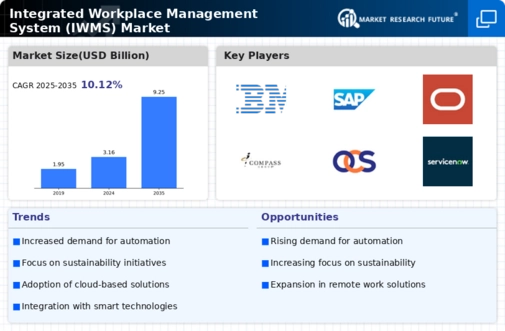Market Growth Projections
The Global Integrated Workplace Management System IWMS Market Industry is poised for substantial growth, with projections indicating a market value of 9.25 USD Billion by 2035. This growth trajectory reflects the increasing adoption of IWMS solutions across various sectors, driven by the need for efficient workplace management. The anticipated CAGR of 10.24% from 2025 to 2035 underscores the market's potential as organizations seek to optimize their operations and enhance employee experiences. As businesses continue to recognize the value of integrated management systems, the IWMS market is likely to expand significantly in the coming years.
Shift Towards Hybrid Work Models
The shift towards hybrid work models is reshaping the Global Integrated Workplace Management System IWMS Market Industry. As organizations adopt flexible work arrangements, the need for effective management of both remote and on-site employees becomes paramount. IWMS solutions provide tools for managing workspace allocation, employee scheduling, and resource utilization, ensuring that businesses can adapt to changing workforce dynamics. This trend is expected to drive the market's growth, as companies invest in IWMS technologies to support their hybrid work strategies. The increasing complexity of workplace management is likely to contribute to the projected market value of 9.25 USD Billion by 2035.
Technological Advancements in IWMS
Technological innovations are significantly influencing the Global Integrated Workplace Management System IWMS Market Industry. The integration of advanced technologies such as artificial intelligence, machine learning, and the Internet of Things is enhancing the functionality of IWMS solutions. These technologies enable real-time data analysis, predictive maintenance, and improved decision-making processes. As organizations seek to streamline operations and enhance user experiences, the adoption of these advanced IWMS solutions is expected to increase. This trend is likely to contribute to the market's growth trajectory, with a projected CAGR of 10.24% from 2025 to 2035.
Enhanced Focus on Employee Experience
The Global Integrated Workplace Management System IWMS Market Industry is witnessing an enhanced focus on employee experience as a key driver. Organizations are increasingly aware that a positive workplace environment directly impacts employee satisfaction and productivity. IWMS solutions offer features that allow for personalized workspace configurations, amenities management, and feedback collection. By leveraging these tools, companies can create a more engaging and supportive work environment. This emphasis on employee experience is likely to fuel the demand for IWMS solutions, as businesses strive to attract and retain top talent in a competitive labor market.
Growing Demand for Space Optimization
The Global Integrated Workplace Management System IWMS Market Industry is experiencing a surge in demand for space optimization solutions. Organizations are increasingly recognizing the need to maximize their real estate assets, leading to a projected market value of 3.16 USD Billion in 2024. This growth is driven by the necessity to reduce operational costs and enhance employee productivity. Companies are leveraging IWMS tools to analyze space utilization metrics and make informed decisions about workspace design. As businesses adapt to evolving work environments, the focus on efficient space management is likely to propel the IWMS market further.
Sustainability Initiatives and Compliance
Sustainability initiatives are becoming a pivotal driver in the Global Integrated Workplace Management System IWMS Market Industry. Organizations are increasingly mandated to comply with environmental regulations and sustainability goals. IWMS solutions facilitate the monitoring and reporting of energy consumption, waste management, and carbon footprint, enabling companies to align with global sustainability standards. This compliance not only enhances corporate reputation but also leads to cost savings through efficient resource management. As businesses prioritize sustainability, the demand for IWMS solutions that support these initiatives is likely to rise, further propelling market growth.

























